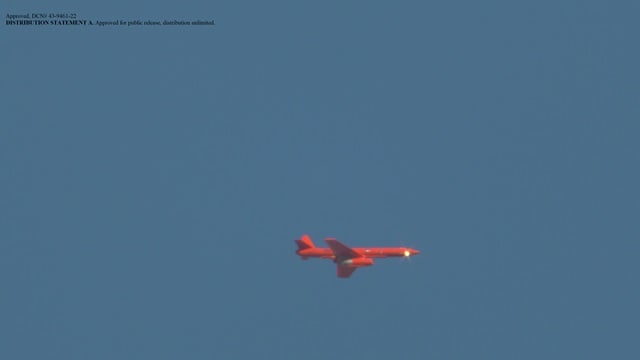ARLINGTON, Va., April 21, 2022 — The U.S. Navy has tested a laser weapon designed to serve as a multidomain, multiplatform demonstration system. The Navy said that the system, developed by Lockheed Martin and called the Layered Laser Defense (LLD), can counter unmanned aerial systems and fast-attack boats with a high-power laser — and also use its high-resolution telescope to track in-bound air threats, support combat identification, and conduct battle damage assessment of engaged targets.
The test, conducted in February, saw the ground-based laser system track a red airborne drone and fire at it with a high-energy laser beam invisible to the naked eye, causing a fiery orange flare followed by smoke pouring from the drone engine as the disabled target opened a parachute.

The Layered Laser Defense weapon shoots down a drone during a February demonstration at the U.S. Army’s High-Energy Laser Systems Test Facility at White Sands Missile Range in N.M. The demonstration marked the first time the U.S. Navy used an all-electric, high-energy laser weapon to defeat a target representing a subsonic cruise missile in flight. Courtesy of Lockheed Martin.
The drone shoot-down by the LLD was part of a recent test sponsored by the Office of Naval Research (ONR) at the U.S. Army’s High-Energy Laser Systems Test Facility at White Sands Missile Range in N.M. The demonstration was a partnership between ONR, the Office of the Under Secretary of Defense (Research and Engineering), and Lockheed Martin.
The LLD testing supports a broader effort by the naval research and development community, partnered closely with the fleet, to develop technologies and field a family of laser weapons that can address multiple threats using a range of escalating options. These capabilities range from nonlethal measures, such as optical “dazzling” and disabling of sensors, to destruction of a target.
Laser weapons provide desirable precision and speed of engagement for naval forces. They also offer simplified logistics that are safer for ships and their crews, as lasers are not dependent on the traditional propellants or gunpowder-based ordnance found on ships.

Instead, modern high-power lasers run on electricity, making them inherently safer and able to provide weapon capability as long as a ship has power. This also means the cost per engagement for a laser weapon can be very low, since the only consumable item expended is fuel to run the system.
“LLD is an example of what a very advanced laser system can do to defeat significant threats to naval forces,” said David Kiel, a former Navy captain who is a program officer in ONR’s Aviation, Force Projection, and Integrated Defense Department, which managed the testing. “And we have ongoing efforts, both at ONR and in other Navy programs, to keep building on these results in the near future.”
During the recent test at White Sands, the LLD tracked or shot down an array of targets — including unmanned fixed-wing aerial vehicles, quadcopters, and high-speed drones representative of subsonic cruise missiles.
“We’re proud to say that the Layered Laser Defense system defeated a surrogate cruise missile threat in partnership with the Navy, White Sands Missile Range, and Army High-Energy Laser Systems Test Facility teams. Lockheed Martin drew best-in-class laser weapon subsystems from across the corporation, including key industry partner Rolls-Royce, to support the entire threat engagement timeline from target detection to defeat,” said Rick Cordaro, vice president, Lockheed Martin Advanced Product Solutions.
“The Navy performed similar tests during the 1980s but with chemical-based laser technologies that presented significant logistics barriers for fielding in an operational environment,” said Frank Peterkin, ONR’s directed energy portfolio manager. “And, ultimately, those types of lasers did not transition to the fleet or any other service.”
In 2014 ONR saw the Laser Weapon System tested successfully aboard the USS Ponce in the Persian Gulf. In 2021, ONR fielded the Laser Weapon System Demonstrator aboard the USS Portland.
Although there’s no plan to field the LLD, it offers a glimpse into the future of laser weapons, according to the Office of Naval Research. It is compact and powerful, yet more efficient than previous systems, and it features specialized optics to observe a target and focus laser beams to maximum effect while also incorporating artificial intelligence to improve tracking and targeting.